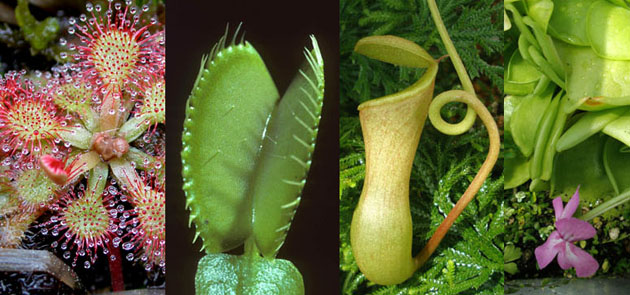
Carnivorous Plants
Some of the most unusual and curious plants on the planet are ones that literally "turn the tables" on their animal predators. These plant attract, capture, and absorb nutrients from animals, thus they are called "carnivorous". It is thought that this trophic (feeding) mode has evolved in response to poor growing conditions, specifically soils lacking in nitrogen. Evolutionary studies have shown that carnivorous plants evolved at least seven times in separate, independent families: Droseraceae, Drosophyllaceae, Biblidaceae, Nepenthaceae, Cephalotaceae, Sarraceniaceae, and Lentibulariaceae. There are also some families that contain plants considered "borderline" carnivores, such as Stylidiaceae, Roridulaceae, Martyniaceae, Bromeliaceae and Eriocaulaceae. An good treatment of carnivorous plants can be found on Wikipedia.
The carnivorous plants can be grouped according to taxonomy or the type of trapping mechanism they use. The traps include pitfalls, flypaper, snap, bladder, and lobster-pot types. For the purposes of this web page, the plants will be arranged taxonomically.
Droseraceae
- Aldrovanda. Relationships to Dionaea and Drosera somewhat unclear. Has a snap-trap mechanism. Many species known from the fossil record.
- Dionaea muscipula. Venus Flytrap. One species in this genus from eastern United States. In PLB Greenhouse
- Drosera. Sundews. A genus with over 190 species and a worldwide distribution. They use a flypaper mechanism of glandular hairs that secrete a sticky mucilage that captures the invertebrates. The leaves undergo movements that also entrap the victim. In PLB Greenhouse
Drosophyllaceae
- Drosophyllum lusitanicum. Portuguese Sundew or Dewy pine. Only one species in this family. Formerly considered part of Droseraceae, molecular evidence indicates it has a separate evolutionary origin.
Biblidaceae
- Byblis. Rainbow Plants. A genus of about seven species, all from Australia. It is classified in the order Lamiales and captures invertebrates by means of passive flypaper traps.
Nepenthaceae
- Nepenthes. Tropical Pitcher Plants or Monkey Cups. A genus of ca. 130 species from the Old World tropics. In PLB Greenhouse
Cephalotaceae
- Cephalotus follicularis. Albany Pitcher Plant. This family contains only one genus and one species. These Australian plants are classified in Oxalidales. They represent the third independent evolution of pitfall traps (pitchers) in flowering plants.
Sarraceniaceae
- Darlingtonia californica. The Cobra Lily. A genus of one species endemic to northern California and Oregon.
- Heliamphora. The Sun or Marsh Pitchers. A genus of 18 species endemic to South America.
- Sarracenia. The North American Trumpet Pitchers. A genus of 8-11 species of North America. In PLB Greenhouse.
Lentibulariaceae
- Genlisea. Corkscrew plant. A genus of ca. 20 species found in Central and South America as well as Africa. They use underground leaves to attract, trap, and digest their prey, which is mostly protozoans. Although suspected by Darwin, carnivory in this genus was not proven until 1998.
- Pinguicula. Butterworts. A genus of ca. 80 species found in North and South America, Europe and Asia. They capture their prey by a passive flypaper mechanism. In PLB Greenhouse
- Utricularia. Bladderworts. A genus of over 200 species distributed worldwide. These plants can be either terrestrial or aquatic and use and incredibly specialized trapping mechanism that involves bladders. The bladder is under negative pressure (vacuum) and is triggered when the prey stimulates bristle-like protruberances.
Websites
The Carnivorous Plant FAO. courtesy of The International Carnivorous Plant Society.
Carnivorous Plants & The Fast-Moving Sensitive Plant. From Wayne's Word.
Carnivorous Plants / Insectivorous Plants. From the Botanical Society of America web site.
